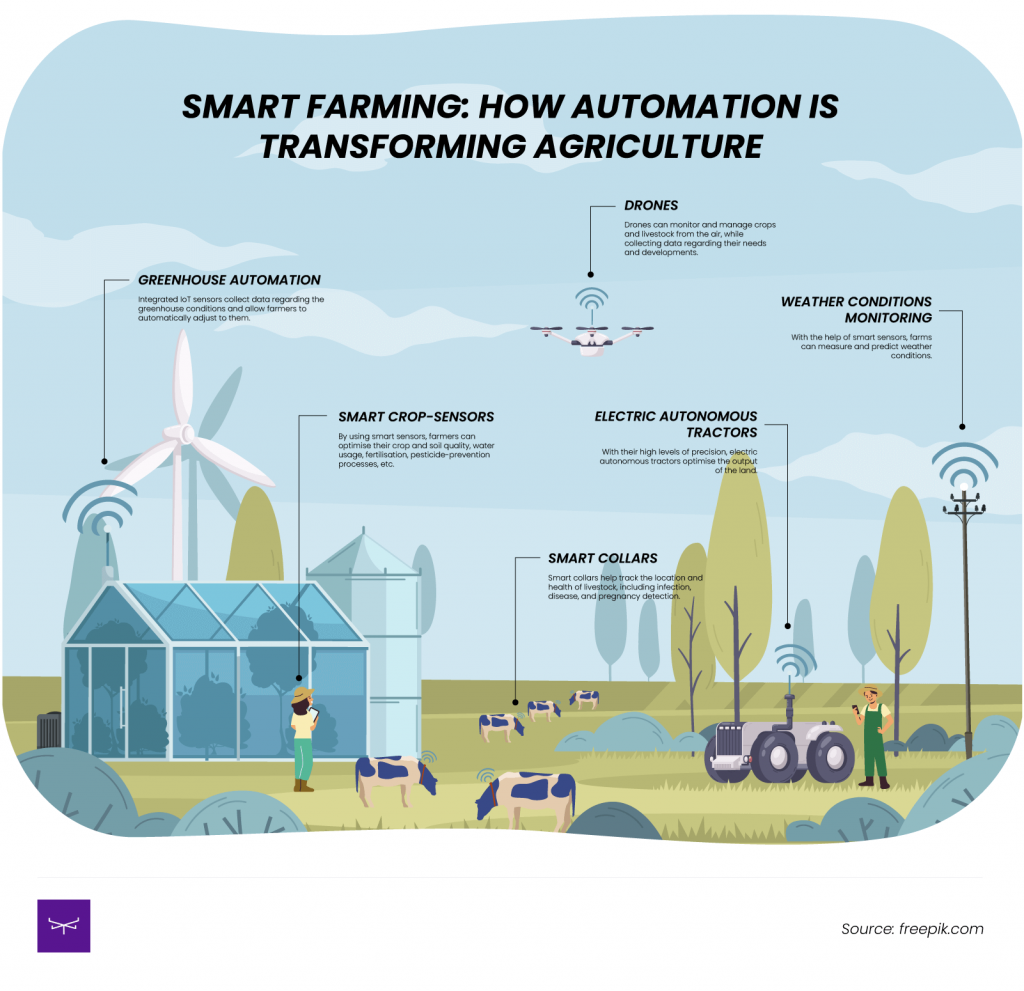As a result of advances in, for example, cloud computing, the Internet of Things (IoT), big data, and robotics, the agricultural sector is expected to see significant technological growth. In a recent guide about smart farming, Meili Robots dives into the concept of smart farming and how automation technologies are reshaping the agriculture industry.
Insights into the Agriculture Market
The agricultural sector is facing a number of major challenges at the moment. These challenges call for a solution, and in today’s market, that solution is related to the adoption of automation technologies: smart farming. Here’s an overview of the three main challenges in agriculture:
1. Population growth

It goes without saying that the world is facing a huge issue when it comes to overpopulation — with current growth numbers predicting an increase of nearly 2 billion people from 2021 to 2050. The reason for this being a huge issue for the agricultural sector, of course, has to do with the food demand. In fact, in order to meet this demand in 2050, agriculture production will need to increase by 70%, says Michelle Schlechtriem, content marketer at Meili Robots.
In addition, the need for sustainable production is ever-increasing, too. The fact that the food industry is responsible for 30% of the world’s energy consumption as well as 22% of global greenhouse gas emissions adds another layer to this challenge. In other words, agricultural production does not only need to increase, but it needs to do so in a more sustainable way.
2. Demand for sustainable foods & beverages
Continuing from the last point mentioned above, sustainability is bringing significant change to the agricultural sector — and many others for that matter. Especially since the Covid-19 pandemic, the demand for immune-boosting foods and supplements has intensified. Moreover, 54% of consumers care more about the healthfulness of their foods and beverages in 2020 than they did in 2010.
Another big trend is the awareness around the environmental footprint of meat. In fact, 27% of respondents to a 2020 US survey said to be concerned about the impact of meat on the environment. As dietary preferences are changing and consumers are becoming more concerned about the environment, the need for sustainable agriculture production will become more and more important.
3. Labour shortages
Being highly dependent on seasonal migrant workers, farmers — especially in the UK — are challenged continuously these days, especially considering the travel restrictions as a result of the Covid-19 pandemic as well as Brexit. In fact, the UK is expected to see a 75% cut in its agricultural workforce. Even before Brexit and the pandemic, the EU saw an outflow of 1.3 million national farm workers between 2011 and 2017.
Putting these challenges together, it is clear that there is a need for a solution that includes automation and new technologies. Could this solution be smart farming? Let’s find out!
Smart Farming
Also known as farming 4.0 or farm automation, smart farming refers to the application of data and information technology in order to improve the production processes of complex farming systems — this includes the optimisation of food quality.
Smart farming is carried out with the help of numerous technologies that enable farmers to monitor their field conditions seamlessly and remotely from one central place. These technologies include the IoT, drones, robotics, automation, artificial intelligence, mapping, statistical processes, and many more.

Common Smart Farming Technologies
The image above illustrates some of the most common smart farming technologies of today. These technologies are driven by automation, making use of software and sensors that allow farmers to monitor and manage their farm’s processes. Let’s take a closer look at them.
Agricultural drones
Drones are already used by quite a few farmers these days, and with good reason. By flying over the fields, drones can easily manage and monitor crops and help farmers carry out their practices in a more sustainable way. With the help of the IoT, drones can collect important data regarding the needs and developments of the crops so that farmers can adjust their practices accordingly.
Smart sensors
With the help of smart sensors all around their fields, farmers can collect detailed information regarding numerous farming activities. Examples include the measurements of soil temperatures, acidity levels, and (future) weather conditions. This allows farmers to adjust their practices accordingly, thereby protecting both crops and livestock.
Smart crop-sensors
By using smart crop-sensors, farmers are able to collect crop-related data that helps them optimise their crop and soil quality, fertilisation, water usage as well as pesticide-prevention processes.
Smart collars
Being specifically designed for livestock, smart collars let farmers track the health and location of their animals. These collars are, for example, able to detect infections, diseases as well as pregnancy.
Robotics
Unsurprisingly, there are many robots roaming the farms these days, with one of the most common ones being the automated milking robot. Another example is the electric autonomous tractor which works in a highly efficient and independent manner while also protecting the soil and environment. Other robots can sow and pull weeds or harvest crops in a more efficient manner — thereby optimising the yield and increasing the farm’s income. The possibilities are endless!
Greenhouse automation
Just as with the previous technologies, greenhouses can now collect real-time information regarding , for example, the temperature, lighting, soil conditions, and humidity with the use of IoT sensors. Moreover, by utilising machine learning in combination with smart weather stations, farmers can automatically adjust their greenhouse’s conditions to match the collected parameters.
End-to-end smart farm management
As we have talked about a lot of different smart farming technologies already — even though there are many more — it is important to recognise the need for a cloud-based, farm productivity management system that can properly streamline the farm’s operations by collecting, analysing, and sending out data.
The benefits of smart farming
By letting farmers adopt technologies such as robotics and automation to their farming practices helps them optimise both the efficiency and sustainability of their production processes.
Here are some of the ways in which smart farming can benefit farmers:
- Water conservation
- Lower operating costs
- Increased production quality and quantity
- Real-time data & production insights
- Reduced environmental impact
- More accurate field and farm evaluation
- Improved livestock well-being and management
- Remote monitoring of fields, livestock, and equipment
By allowing farmers to make maximum use of their resources while also minimising the environmental footprint of their production processes, the implementation of smart farming practices can play a huge role in addressing the three challenges mentioned above.
As farmers are able to collect, access, and use large volumes of data, their production processes can be optimised in a both more profitable and sustainable manner while also improving global food security. It will be interesting to see how smart farming technologies will develop and influence the farming of the future!










